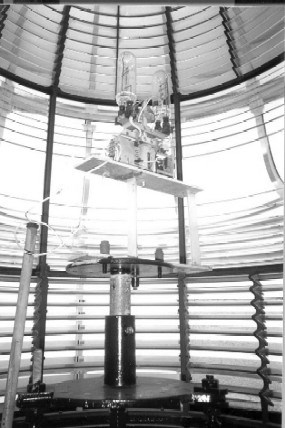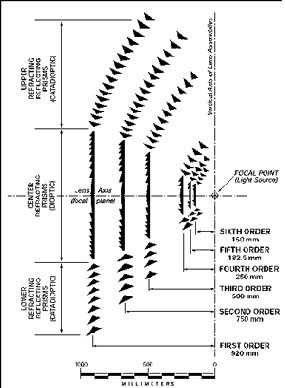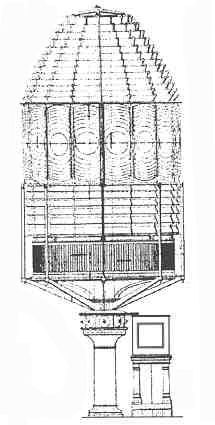|
Mariners have depended on lights for navigation for over 2,000 years. The ancient Egyptians built light towers and priests tended the beacon fires. The Romans maintained beacons at prominent ports throughout their empire. By the 18th century, light platforms protected many of Europe’s most dangerous coasts. These early lights were little more than open bonfires on raised platforms, but they warned sailors of danger and gave them hope of safe harbor during storms. As maritime travel and commerce increased, so did the quantity and quality of navigational lights. Brick and metal lighthouses replaced wooden platforms. Brighter burning oil lamps took the place of simple wood or coal fires. Parabolic or spherical reflectors were added to concentrate the lights and increase visibility. But one of the greatest improvements in lighthouse technology came in 1822 when a French physicist named Augustin Jean Fresnel (Freh-nel) introduced a new lens design that would revolutionize lighthouse optics and make waterways safer for sailors around the world. 
Fresnel’s lens resembles a giant beehive with a complex system of multi-faceted glass prisms mounted in a brass framework. The prisms reflect and refract (bend) light and magnify it, thereby taking rays of light that would normally scatter in all directions and focusing them into a single beam. Because of this design, a Fresnel lens is much more efficient than traditional light sources. Tests show that an open flame loses nearly 97% of its light. A light with a reflector placed behind it loses 60-80% of its light. A Fresnel lens, however, loses a maximum of 20% of its light. This concentrated light of Fresnel’s lens vastly improved lighthouse effectiveness. Before its invention, the brightest lighthouse beams could only be seen from 8-12 miles away. The light from a Fresnel lens could shine all the way to the horizon, more than 20 miles away.
Another innovation of the Fresnel lens is its ability to produce individual light patterns called characteristics. Prior to the Fresnel lens, most lighthouses had only solid, steady lights. This made it difficult to distinguish one light from another, often causing confusion and dangerous conditions for passing ships. But the Fresnel lens could produce an almost unlimited combination of patterns, depending on the number of installed flash panels and the speed that the lens revolved. Originally a clockwork type mechanism was used to rotate the lens around the lamp to produce a flash. With individual flash patterns, lighthouses along the same coast are easily differentiated and recognized, thereby better aiding mariners. Furthermore, although most lights are white, some use red or green lights or a combination of the two as another way to distinguish them. 
Fresnel lenses are divided into different sizes, called orders. The first order lens is the largest and most powerful. It can be 12 feet in height and more than 6 feet in diameter. Used primarily as a seacoast light, its beam is visible over twenty miles out to sea. The sixth order is the smallest lens, being only about one foot wide and used in harbors and channels. The genius of Fresnel’s invention is that it improved existing lights on several fronts—brightness, distance, efficiency and recognition. Because of these technical advancements, it is easy to overlook the beauty of the lens itself. It is truly a work of art. Most Fresnel lenses contain hundreds of glass prisms which were painstakingly ground, cut, and polished. They sparkle like jewels when lit at night. Augustin Fresnel’s work on lighthouse optics earned him a prestigious award from the French Academy of Science and his superior lens was soon installed in lighthouses all over Europe. His invention, however, took some time to reach the United States. In the meantime, ships sailing through the dangerous waters off the Outer Banks learned firsthand why the area is called the “Graveyard of the Atlantic”. Powerful currents, hidden shoals, and unrelenting storms made navigation extremely challenging and contributed to thousands of shipwrecks in these waters. The existing lighthouses were ineffective and instead of saving lives, were often putting them at risk. One frustrated ship’s captain described the Cape Hatteras Lighthouse as “a disgrace to our country.” Another claimed to never have seen it in nine trips down the coast. Many captains argued that it would be better to eliminate the lighthouses altogether rather than risk their ships searching for the dim towers. Finally, to the relief of many mariners, the Fresnel lens made its way to the Outer Banks. By 1859, almost all of the North Carolina’s lighthouses were equipped with Fresnel lenses. 
Many lighthouses around the world still operate today with Fresnel lenses and countless others are on display in museums and visitor centers. Cape Hatteras National Seashore has two Fresnel lenses still in operation. The Ocracoke Island Lighthouse has a fourth order lens that produces a solid, steady light visible for 14 miles. The Bodie Island Lighthouse has a first order Fresnel lens with an interesting flash pattern. The light is on for 2.5 seconds, off for 2.5 seconds, on for 2.5 seconds, and then off for 22.5 seconds. The Cape Hatteras Lighthouse’s first order Fresnel lens was damaged by vandals and had to be replaced with an aerobeacon that flashes every 7.5 seconds.
It is impossible to determine how many lives were saved as a result of Fresnel’s work, but it is certainly a significant number. Perhaps even harder to quantify is the sense of security and relief that reliable and effective lighthouses brought to mariners’ lives. Unfortunately, Augustin Fresnel was not able to enjoy the fame and wealth of his invention. He died of tuberculosis in 1827 at the age of thirty-nine. His legacy, however, remains intact as the Fresnel lens forever changed the way a lighthouse works. |
Last updated: April 14, 2015
